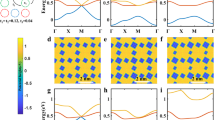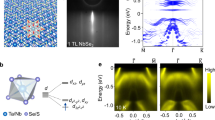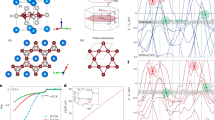Abstract
Electron hopping on spatially periodic lattices gives rise to intriguing electronic behaviour. For example, hopping on the geometrically frustrated two-dimensional kagome, dice and Lieb lattices yields electronic band structures with both massless Dirac-like and perfectly dispersion-less, flat bands. As materials featuring the dice and Lieb lattice structures are scarce, an alternative approach proposes to leverage atomic orbitals to realize the characteristic electron hopping of geometrically frustrated lattices. This strategy promises to expand the list of candidate materials with frustrated electron hopping, but is yet to be shown in experiments. Here we demonstrate frustrated hopping in the van der Waals intermetallic Pd5AlI2, emerging from the arrangement of atomic orbitals in a primitive square lattice. Using angle-resolved photoemission spectroscopy and quantum oscillation measurements, we reveal that the band structure of Pd5AlI2 includes linear Dirac-like bands intersected at their crossing point by a locally flat band—an essential characteristic of frustrated hopping in Lieb and dice lattices. Moreover, this compound shows exceptional chemical stability, with its unusual bulk band structure and metallicity persisting in ambient conditions down to the monolayer limit. Hence, our results showcase a way to realize electronic structures characteristic of geometrically frustrated lattices in non-frustrated systems.
This is a preview of subscription content, access via your institution
Access options
Access Nature and 54 other Nature Portfolio journals
Get Nature+, our best-value online-access subscription
$32.99 / 30 days
cancel any time
Subscribe to this journal
Receive 12 print issues and online access
$259.00 per year
only $21.58 per issue
Buy this article
- Purchase on SpringerLink
- Instant access to full article PDF
Prices may be subject to local taxes which are calculated during checkout




Similar content being viewed by others
Data availability
The data that support the findings of this study are presented in the published figures and tables and are available via the Harvard Dataverse repository at https://doi.org/10.7910/DVN/NAD0B9. Further data are available from the corresponding authors upon reasonable request.
References
Stewart, G. R. Heavy-fermion systems. Rev. Mod. Phys. 56, 755–787 (1984).
Bergman, D. L., Wu, C. & Balents, L. Band touching from real-space topology in frustrated hopping models. Phys. Rev. B 78, 125104 (2008).
Mielke, A. Ferromagnetic ground states for the Hubbard model on line graphs. J. Phys. A: Math. Gen. 24, L73 (1991).
Horiguchi, T. & Chen, C. C. Lattice Green’s function for the diced lattice. J. Math. Phys. 15, 659–660 (1974).
Lieb, E. H. Two theorems on the Hubbard model. Phys. Rev. Lett. 62, 1201–1204 (1989).
Yin, J.-X. et al. Quantum-limit Chern topological magnetism in TbMn6Sn6. Nature 583, 533–536 (2020).
Kang, M. et al. Dirac fermions and flat bands in the ideal kagome metal FeSn. Nat. Mater. 19, 163–169 (2020).
Ye, L. et al. Hopping frustration-induced flat band and strange metallicity in a kagome metal. Nat. Phys. 20, 610–614 (2024).
Wakefield, J. P. et al. Three-dimensional flat bands in pyrochlore metal CaNi2. Nature 623, 301–306 (2023).
Huang, J. et al. Non-Fermi liquid behaviour in a correlated flat-band pyrochlore lattice. Nat. Phys. 20, 603–609 (2024).
Lee, C.-C., Fleurence, A., Yamada-Takamura, Y. & Ozaki, T. Hidden mechanism for embedding the flat bands of Lieb, kagome, and checkerboard lattices in other structures. Phys. Rev. B 100, 045150 (2019).
Liu, H., Sethi, G., Meng, S. & Liu, F. Orbital design of flat bands in non-line-graph lattices via line-graph wave functions. Phys. Rev. B 105, 085128 (2022).
Bercioux, D., Urban, D. F., Grabert, H. & Häusler, W. Massless Dirac-Weyl fermions in a 𝒯3 optical lattice. Phys. Rev. A 80, 063603 (2009).
Xia, S. et al. Unconventional flatband line states in photonic Lieb lattices. Phys. Rev. Lett. 121, 263902 (2018).
Shen, R., Shao, L. B., Wang, B. & Xing, D. Y. Single Dirac cone with a flat band touching on line-centered-square optical lattices. Phys. Rev. B 81, 041410 (2010).
Santos, L. et al. Atomic quantum gases in kagomé lattices. Phys. Rev. Lett. 93, 030601 (2004).
Jo, G.-B. et al. Ultracold atoms in a tunable optical kagome lattice. Phys. Rev. Lett. 108, 045305 (2012).
Taie, S. et al. Coherent driving and freezing of bosonic matter wave in an optical Lieb lattice. Sci. Adv. 1, e1500854 (2015).
Merker, H.-B., Schäfer, H. & Krebs, B. Neue PdxAly-phasen und die verbindung Pd5AII2. Z. Anorg. Allg. Chem. 462, 49–56 (1980).
Le Blanc, M., Richter, K. & Schiebold, E. Eine früfung der tammannschen theorie der resistenzgrenzen am system gold–kupfer. Aufstellung neuer gesichtspunkte. Ann. Phys. 391, 929–1005 (1928).
Lan, Z., Goldman, N., Bermudez, A., Lu, W. & Öhberg, P. Dirac-Weyl fermions with arbitrary spin in two-dimensional optical superlattices. Phys. Rev. B 84, 165115 (2011).
Dóra, B., Kailasvuori, J. & Moessner, R. Lattice generalization of the Dirac equation to general spin and the role of the flat band. Phys. Rev. B 84, 195422 (2011).
Semenoff, G. W. Condensed-matter simulation of a three-dimensional anomaly. Phys. Rev. Lett. 53, 2449–2452 (1984).
Zhang, Y., Tan, Y.-W., Stormer, H. L. & Kim, P. Experimental observation of the quantum Hall effect and Berry’s phase in graphene. Nature 438, 201–204 (2005).
Novoselov, K. S. et al. Two-dimensional gas of massless Dirac fermions in graphene. Nature 438, 197–200 (2005).
Khestanova, E. et al. Unusual suppression of the superconducting energy gap and critical temperature in atomically thin NbSe2. Nano Lett. 18, 2623–2629 (2018).
Park, C.-H., Yang, L., Son, Y.-W., Cohen, M. L. & Louie, S. G. Anisotropic behaviours of massless Dirac fermions in graphene under periodic potentials. Nat. Phys. 4, 213–217 (2008).
Devarakonda, A. et al. Clean 2D superconductivity in a bulk van der Waals superlattice. Science 370, 231–236 (2020).
Legros, A. et al. Universal T-linear resistivity and Planckian dissipation in overdoped cuprates. Nat. Phys. 15, 142–147 (2019).
Cao, Y. et al. Strange metal in magic-angle graphene with near Planckian dissipation. Phys. Rev. Lett. 124, 076801 (2020).
Ghiotto, A. et al. Quantum criticality in twisted transition metal dichalcogenides. Nature 597, 345–349 (2021).
Hwang, E. H. & Das Sarma, S. Linear-in-T resistivity in dilute metals: a Fermi liquid perspective. Phys. Rev. B 99, 085105 (2019).
Polshyn, H. et al. Large linear-in-temperature resistivity in twisted bilayer graphene. Nat. Phys. 15, 1011–1016 (2019).
Cao, C. et al. Full control of solid-state electrolytes for electrostatic gating. Adv. Mater. 35, 2211993 (2023).
Thinel, M. et al. Electronic bound states in the continuum in a 2D metal. Preprint at https://arxiv.org/abs/2410.19227 (2024).
Urban, D. F., Bercioux, D., Wimmer, M. & Häusler, W. Barrier transmission of Dirac-like pseudospin-one particles. Phys. Rev. B 84, 115136 (2011).
Weeks, C. & Franz, M. Topological insulators on the Lieb and perovskite lattices. Phys. Rev. B 82, 085310 (2010).
Lai, H.-H., Grefe, S. E., Paschen, S. & Si, Q. Weyl–Kondo semimetal in heavy-fermion systems. Proc. Natl Acad. Sci. USA 115, 93–97 (2018).
Ranninger, J. & Robaszkiewicz, S. Superconductivity of locally paired electrons. Phys. B+C 135, 468–472 (1985).
Micnas, R., Ranninger, J. & Robaszkiewicz, S. Superconductivity in narrow-band systems with local nonretarded attractive interactions. Rev. Mod. Phys. 62, 113–171 (1990).
Novoselov, K. S. et al. Electric field effect in atomically thin carbon films. Science 306, 666–669 (2004).
Treadwell, W. D. & Obrist, A. Über die bestimmung und bildung von oxydischen deckschichten auf aluminium. Helv. Chim. Acta 26, 1816–1828 (1943).
Cabrera, N. & Mott, N. F. Theory of the oxidation of metals. Rep. Prog. Phys. 12, 163–184 (1949).
Kepp, K. P. Chemical causes of metal nobleness. ChemPhysChem 21, 360–369 (2020).
Bergman, G. Influence of spin-orbit coupling on weak localization. Phys. Rev. Lett. 48, 1046–1049 (1982).
Das Sarma, S. & Stern, F. Single-particle relaxation time versus scattering time in an impure electron gas. Phys. Rev. B 32, 8442–8444 (1985).
Rhodes, D., Chae, S. H., Ribeiro-Palau, R. & Hone, J. Disorder in van der Waals heterostructures of 2D materials. Nat. Mater. 18, 541–549 (2019).
Zhu, J., Li, T., Young, A. F., Shan, J. & Mak, K. F. Quantum oscillations in two-dimensional insulators induced by graphite gates. Phys. Rev. Lett. 127, 247702 (2021).
Briggs, N. et al. Atomically thin half-van der Waals metals enabled by confinement heteroepitaxy. Nat. Mater. 19, 637–643 (2020).
Fang, N., Lee, H., Sun, C. & Zhang, X. Sub-diffraction-limited optical imaging with a silver superlens. Science 308, 534–537 (2005).
da Jornada, F. H., Xian, L., Rubio, A. & Louie, S. G. Universal slow plasmons and giant field enhancement in atomically thin quasi-two-dimensional metals. Nat. Commun. 11, 1013 (2020).
Rodrigo, D. et al. Mid-infrared plasmonic biosensing with graphene. Science 349, 165–168 (2015).
Zagorac, D., Müller, H., Ruehl, S., Zagorac, J. & Rehme, S. Recent developments in the Inorganic Crystal Structure Database: theoretical crystal structure data and related features. J. Appl. Crystallogr. 52, 918–925 (2019).
Sheldrick, G. M. SHELXT—integrated space-group and crystal-structure determination. Acta Cryst. A71, 3–8 (2015).
Sheldrick, G. M. Crystal structure refinement with SHELXL. Acta Cryst. C71, 3–8 (2015).
Dolomanov, O. V., Bourhis, L. J., Gildea, R. J., Howard, J. A. K. & Puschmann, H. OLEX2: a complete structure solution, refinement and analysis program. J. Appl. Crystallogr. 42, 339–341 (2009).
Giannozzi, P. et al. Advanced capabilities for materials modelling with Quantum ESPRESSO. J. Phys. Condens. Matter 29, 465901 (2017).
Vanderbilt, D. Soft self-consistent pseudopotentials in a generalized eigenvalue formalism. Phys. Rev. B 41, 7892–7895 (1990).
Perdew, J. P., Burke, K. & Ernzerhof, M. Generalized gradient approximation made simple. Phys. Rev. Lett. 77, 3865–3868 (1996).
Georgescu, A. B., Millis, A. J. & Rondinelli, J. M. Trigonal symmetry breaking and its electronic effects in the two-dimensional dihalides MX2 and trihalides MX3. Phys. Rev. B 105, 245153 (2022).
Georgescu, A. Wannier90 Hamiltonian tools. GitHub https://github.com/alexandrub53/Wannier90HamiltonianTools (2022).
Kawamura, M. FermiSurfer: Fermi-surface viewer providing multiple representation schemes. Comput. Phys. Commun. 239, 197–203 (2019).
Blaha, P. et al. WIEN2k: an APW+lo program for calculating the properties of solids. J. Chem. Phys. 152, 074101 (2020).
Wasserman, S. R., Tao, Y. T. & Whitesides, G. M. Structure and reactivity of alkylsiloxane monolayers formed by reaction of alkyltrichlorosilanes on silicon substrates. Langmuir 5, 1074–1087 (1989).
Wang, L. et al. One-dimensional electrical contact to a two-dimensional material. Science 342, 614–617 (2013).
Lee, H. N. S., McKinzie, H., Tannhauser, D. S. & Wold, A. The low‐temperature transport properties of NbSe2. J. Appl. Phys. 40, 602–604 (1969).
Tsen, A. W. et al. Nature of the quantum metal in a two-dimensional crystalline superconductor. Nat. Phys. 12, 208–212 (2016).
Zhao, S. Y. F. et al. Sign-reversing Hall effect in atomically thin high-temperature Bi2.1Sr1.9CaCu2.0O8+δ superconductors. Phys. Rev. Lett. 122, 247001 (2019).
Zhu, C. S. et al. Evolution of transport properties in FeSe thin flakes with thickness approaching the two-dimensional limit. Phys. Rev. B 104, 024509 (2021).
Lei, S. et al. High mobility in a van der Waals layered antiferromagnetic metal. Sci. Adv. 6, eaay6407 (2020).
Lai, Z. et al. Metastable 1T′-phase group VIB transition metal dichalcogenide crystals. Nat. Mater. 20, 1113–1120 (2021).
Lei, S. High mobility in a van der Waals layered antiferromagnetic metal. Sci. Adv. 6, eaay6407 (2020).
Chen, L. et al. Exceptional electronic transport and quantum oscillations in thin bismuth crystals grown inside van der Waals materials. Nat. Mater. 23, 741–746 (2024).
Acknowledgements
We thank J. L. Pack, M. A. Kapfer, E. J. Telford, S. E. Turkel and J. G. Checkelsky for fruitful discussions. Research on novel hopping models was conducted as part of the Programmable Quantum Materials, an Energy Frontier Research Center, funded by the US Department of Energy (DOE), Office of Science, Basic Energy Sciences, under award no. DE-SC0019443 (X.R., C.R.D., A.N.P., R.Q., X.Z. and M.D.). X.R. acknowledges support from a Brown Investigator Award, a program of the Brown Institute for Basic Sciences at the California Institute of Technology. The synthesis and structural characterization of the 2D metal were supported by the NSF MRSEC program through the Center for Precision-Assembled Quantum Materials at Columbia University, award no. DMR-2011738 (X.R., C.R.D., A.N.P. and X.Z.). X.Z. acknowledges support for STM/STS experiments by the Air Force Office of Scientific Research under award no. FA9550-22-1-0389. The Physical Property Measurement System used to perform vibrating-sample magnetometry and electrical transport measurements was purchased with financial support from the National Science Foundation through a supplement to award no. DMR-1751949 (X.R.). A.D. acknowledges support from the Simons Foundation Society of Fellows (grant no. 855186). High-magnetic-field measurements were performed at the National High Magnetic Field Laboratory, supported by the National Science Foundation Cooperative Agreement no. DMR-1644779 and the State of Florida. ARPES measurements used resources at the 21-ID (Electron Spectro-Microscopy) beamline of the National Synchrotron Light Source II, a US DOE, Office of Science User Facility, operated for the DOE, Office of Science, Brookhaven National Laboratory, under contract no. DE-SC0012704.
Author information
Authors and Affiliations
Contributions
C.S.K. and D.G.C. synthesized and characterized the bulk crystals. S.Y.H. supported with the energy-dispersive X-ray spectroscopy and scanning electron microscopy experiments, and M.E.Z. supported with the magnetization measurements. A.D. fabricated the nanodevices and performed the transport characterization. A.D., C.S.K. and D.G.C. conducted the high-field measurements. M.T. performed the STM characterization. A.K.K. performed the ARPES measurements with support from A.R. and E.V. K.W. and T.T. provided the hexagonal boron nitride crystals. Z.L., A.B.G., A.D. and R.Q. performed the theoretical calculations. A.N.P., R.Q., C.R.D. and X.R. supervised the project. A.D., C.R.D. and X.R. wrote the manuscript with input from all authors.
Corresponding authors
Ethics declarations
Competing interests
The authors declare no competing interests.
Peer review
Peer review information
Nature Physics thanks Zurab Guguchia, Hongyan Lu and the other, anonymous, reviewer(s) for their contribution to the peer review of this work.
Additional information
Publisher’s note Springer Nature remains neutral with regard to jurisdictional claims in published maps and institutional affiliations.
Extended data
Extended Data Fig. 1 SEM imaging and EDS of Pd5AlI2.
a SEM image of Pd5AlI2 single crystal outlined in white. b EDS from a representative area scan on the crystal shown. Using statistics collected from ten area scans using the Al content as the reference, the Pd stoichiometry is 4.783 ± 0.174, Al stoichiometry is 1.0, and I stoichiometry is 1.843 ± 0.049.
Extended Data Fig. 2 ARPES electronic structure and photon energy dependence.
ARPES E(k) intensity map (LH polarization) along the \(\overline{\rm{M}}-\overline{{\Gamma}}-\overline{\rm{M}}\) line of the surface BZ at various incoming photon energies hν, a 127 eV b 136 eV and c 142 eV, probing distinct slices of kz, marked in e. The weak variation of these maps evidences the quasi-2D nature of the electronic structure. d ARPES Fermi surface cross-sections in the kx – ky plane (LV polarization) at various kz. The cross-sections are similarly invariant with kz. e An ARPES kz – k|| map along the \(\overline{\rm{M}}-\overline{{\Gamma}}-\overline{\rm{M}}\) line (LH polarization) exhibits cylindrical FSs for all three pockets. The dashed lines show the approximate kz sampled by the E(k) maps a – c. ARPES FS maps (hν = 125 eV) at f 100 meV g 150 meV h and 750 meV below EF. The experimental maps show good correspondence to DFT calculated FSs at i 100 meV j 150 meV and k 645 meV below EF.
Extended Data Fig. 3 Pd5AlI2 AFM topography and optical contrast.
a Topography of terraced Pd5AlI2 flake exfoliated onto SiO2/Si wafer measured by AFM with b linecut along magenta segment showing single Pd5AlI2 layer steps. c Optical microscope image of the same flake showing d contrast in the red, green, and blue color channels between regions of varying thickness. e Spinning a layer of PMMA over the flake f enhances optical contrast, making it easier to distinguish regions with different layer number.
Supplementary information
Supplementary Information
Supplementary Sections I–IV, Figs. 1–5 and Discussion.
Rights and permissions
Springer Nature or its licensor (e.g. a society or other partner) holds exclusive rights to this article under a publishing agreement with the author(s) or other rightsholder(s); author self-archiving of the accepted manuscript version of this article is solely governed by the terms of such publishing agreement and applicable law.
About this article
Cite this article
Devarakonda, A., Koay, C.S., Chica, D.G. et al. Frustrated electron hopping from the orbital configuration in a two-dimensional lattice. Nat. Phys. 21, 1260–1266 (2025). https://doi.org/10.1038/s41567-025-02953-2
Received:
Accepted:
Published:
Issue date:
DOI: https://doi.org/10.1038/s41567-025-02953-2



